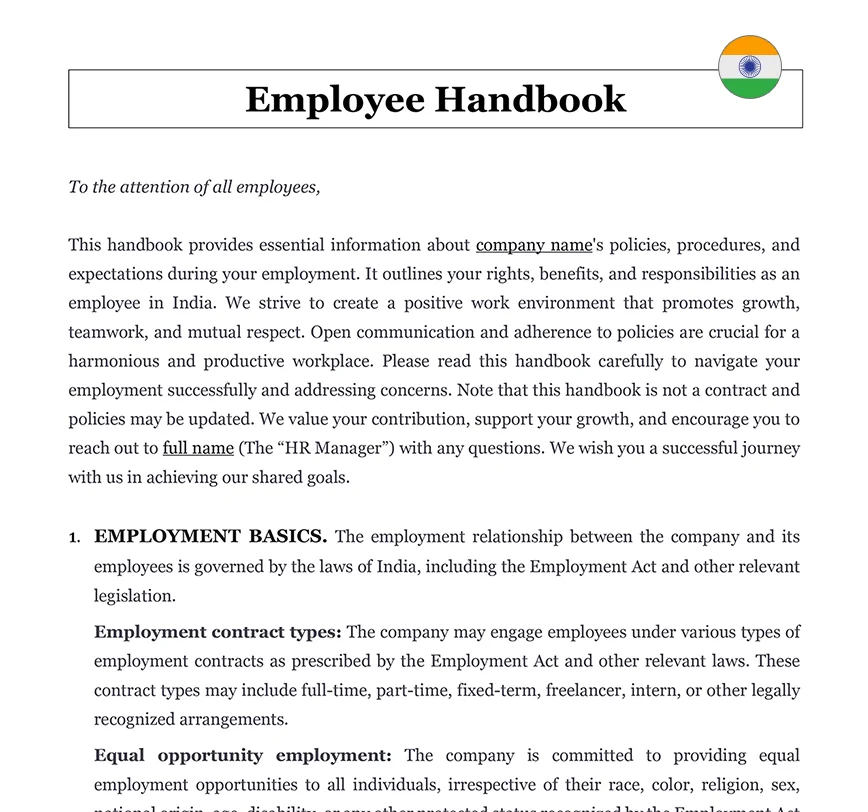Ready to use legal template
Drafted by experienced lawyers
Compliant with Indian law
Ready to use legal template
Drafted by lawyers
Compliant with Indian law
Learn more about Employee Handbook in India
An Employee Handbook is a comprehensive guide that outlines a company’s policies, procedures, and expectations for its employees. It serves as an essential resource for both employers and employees, providing clarity on matters such as workplace conduct, attendance, compensation, leave entitlements, disciplinary actions, and other key HR practices. In India, an Employee Handbook is particularly important as it helps ensure compliance with labour laws such as the Shops and Establishments Act, the Industrial Employment (Standing Orders) Act, and the Payment of Gratuity Act, among others. It also promotes consistency and transparency in managing the workforce. Download our Employee Handbook available in an easy to edit Word format and drafted by expert to be used in India.
Table of contents
What is an Employee Handbook?
An Employee Handbook is a comprehensive document created by an organization to communicate its policies, procedures, expectations, and guidelines to employees. It serves as a centralized resource providing information about the workplace, employment conditions, and the organization’s culture.
Why is an Employee Handbook important?
An Employee Handbook is important because it provides a centralized source of information about organizational policies, expectations, and guidelines. It ensures consistency, helps maintain legal compliance, empowers employees by communicating their rights and benefits, and serves as a valuable resource for conflict resolution and efficient HR management. It also contributes to a positive workplace culture and aligns employees with the organization’s mission and values.
What should an Employee Handbook include?
An Employee Handbook typically includes a range of information to guide employees and communicate organizational policies and expectations. While the specific content can vary based on the organization’s needs, industry, and legal requirements, here are common elements found in many Employee Handbooks:
Introduction: Welcome message and an overview of the company’s mission, values, and culture.
Employment Relationship: At-will employment statement, employment classifications, and any contractual agreements.
Code of Conduct: Expectations for employee behavior, professionalism, and adherence to ethical standards.
Policies and Procedures: Detailed policies on various aspects, such as attendance, dress code, workplace safety, anti-discrimination, and harassment.
Compensation and Benefits: Information about salary, wages, benefits, leave policies, holidays, and bonus structures.
Employee Responsibilities: Outline of employee responsibilities and expectations in terms of job performance, collaboration, and communication.
Employee Benefits and Perks: Details about employee benefits, including health insurance, retirement plans, and additional perks.
Communication Channels: Information on communication channels within the organization and how employees can voice concerns or seek assistance.
Training and Development: Policies and opportunities for employee training, professional development, and growth.
Disciplinary Procedures: Guidelines on disciplinary procedures, including steps for addressing misconduct or performance issues.
Termination Procedures: Information on the organization’s procedures for termination, resignation, and exit interviews.
Legal Compliance: Assurance of compliance with relevant employment laws and regulations.
Anti-Harassment and Non-Discrimination Policies: Statements and policies promoting a workplace free of harassment and discrimination.
Confidentiality and Data Protection: Policies related to the confidentiality of company information and the protection of employee and client data.
Acknowledgment of Receipt: A section where employees acknowledge that they have received, read, and understood the contents of the Employee Handbook.
Can policies in the Employee Handbook be changed?
Policies in the Employee Handbook can be changed, and organizations often update them to reflect legal, organizational, or industry changes. This allows for adaptability to evolving circumstances and the improvement of workplace practices. Changes are typically communicated to employees with transparency, and organizations may involve legal, HR, and relevant departments in the review process.
Ensuring legal compliance, consistency in application, and clear communication are essential aspects of modifying policies. Regular reviews of the Employee Handbook help maintain its relevance, and documentation of changes is important for legal and compliance purposes.
How is the Employee Handbook enforced in India?
In India, the enforcement of the Employee Handbook involves ensuring legal compliance with local employment laws and regulations. This is achieved through clear communication, acknowledgment from employees regarding the receipt and understanding of the handbook, and training sessions to educate employees about its contents.
Consistent application of policies, disciplinary procedures outlined in the handbook, and engagement with employees contribute to effective enforcement. Regular reviews and updates of the handbook, along with proper documentation of enforcement actions, are essential. In cases of legal complexities, organizations may seek legal consultation to align their policies with Indian labor laws. Overall, enforcement requires a flexible and adaptable approach to address evolving legal and organizational considerations.
Where can employees access the Employee Handbook?
Employees can access the Employee Handbook through various channels, including physical copies distributed during onboarding or available in HR offices. Many organizations maintain a digital version on internal intranets, employee portals, or document management systems. Distribution may occur through email, mobile applications, or on the company’s public website.
Some employees may receive the handbook during training sessions or orientations, and acknowledgment forms may be used to confirm receipt and understanding. Offering multiple access points ensures that employees can conveniently refer to the handbook, whether in print or digital format, aligning with the organization’s technology infrastructure and preferences.
SPECIAL OFFER
HR Pro
15 Document Package
Essential documents for managing employees in India
Share information
Why Themis Partner ?
Make documents forhundreds of purposes
Hundreds of documents
Instant access to our entire library of documents for India.
24/7 legal support
Free legal advice from our network of qualified lawyers.
Easily customized
Editable Word documents, unlimited revisions and copies.
Legal and Reliable
Documents written by lawyers that you can use with confidence.




